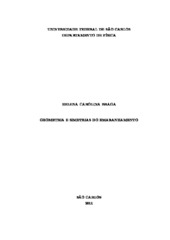| dc.contributor.author | Braga, Helena Carolina | |
| dc.date.accessioned | 2016-06-02T20:15:24Z | |
| dc.date.available | 2011-11-24 | |
| dc.date.available | 2016-06-02T20:15:24Z | |
| dc.date.issued | 2011-05-20 | |
| dc.identifier.citation | BRAGA, Helena Carolina. Geometria e simetrias do emaranhamento. 2011. 147 f. Tese (Doutorado em Ciências Exatas e da Terra) - Universidade Federal de São Carlos, São Carlos, 2011. | por |
| dc.identifier.uri | https://repositorio.ufscar.br/handle/ufscar/4937 | |
| dc.description.abstract | In the present work we present a geometric method to identify and measure the degree of entanglement of a two-qubit state. It is based on writing a map of the system state, from a non-unitary transformation. By introducing new parameters for such 4X4 matrix, the product of eigenvalues, two by two, acquire the form of squared 4D distances, having a Minkowski metric. If the squared distance is of the kind timelike, i.e.non-negative, the two-qubit system is separable. Otherwise, if it is spacelike, namely, the squared distance is negative, the two qubits are entangled. Besides being invariant by unitary transformations on the system state, the distances can be represented in a hyperbolic parameterized phase space, allowing a suitable graphic representation, i. e., in a phase space where the system trajectories can be drawn. The method is extended to a large class of 4x4 positive matrices having at most seven independent parameters, the D-7 manifold class. Using group theory methods we classify these states according to the symmetries of seven generators, where one of them commutes with the others. We illustrate the method and the theory by presenting several two-qubit systems found in the literature. We also study the symmetry breaking and the criticality in two-qubit Heisenberg Models, looking for signatures of quantum phase transitions in terms of the squared distances as well as in its derivatives. | eng |
| dc.description.sponsorship | Universidade Federal de Sao Carlos | |
| dc.format | application/pdf | por |
| dc.language | por | por |
| dc.publisher | Universidade Federal de São Carlos | por |
| dc.rights | Acesso Aberto | por |
| dc.subject | Teoria quântica | por |
| dc.subject | Transição de fase | por |
| dc.subject | Geometria de Minkowski | por |
| dc.title | Geometria e simetrias do emaranhamento | por |
| dc.type | Tese | por |
| dc.contributor.advisor1 | Mizrahi, Salomon Sylvain | |
| dc.contributor.advisor1Lattes | http://lattes.cnpq.br/8143137168199991 | por |
| dc.description.resumo | O presente trabalho apresenta um método geométrico de caracterização e quanti.- cação de emaranhamento para sistemas de dois qubits baseado em mapas não unitários. Introduzimos novos parâmetros para o operador densidade de estados, de tal forma que o produto dos autovalores, dois a dois, adquirisse a forma de distâncias quadráticas no espaço quadridimensional, estas distâncias obedecem a métrica de Minkowski. Quando tais distâncias quadráticas forem não negativas o sistema é dito separável, por outro lado quando forem negativas o sistema está emaranhado. As distâncias quadráticas propostas são invariantes por transformações unitárias e podem ser representadas gra.camente em um espaço de fase hiperbólico parametrizado, onde uma análise quantitativa pode ser realizada e até mesmo trajetórias podem ser traçadas. O método é extendido para uma classe maior de estados de variedade D-7; isto é, com até sete parâmetros independentes, através do uso de teoria de grupos, onde classi.camos os estados de acordo com as sime- trias de seus sete geradores, sendo que um deles comuta com todos os outros. O método é ilustrado ao longo do trabalho com uma série de exemplos presentes na literatura. Por .m, estudamos as quebras de simetria em sistemas de Heisenberg de dois qubits procurando assinaturas de transições de fase quânticas de primeira ordem nas distâncias propostas e em suas derivadas. | por |
| dc.publisher.country | BR | por |
| dc.publisher.initials | UFSCar | por |
| dc.publisher.program | Programa de Pós-Graduação em Física - PPGF | por |
| dc.subject.cnpq | CIENCIAS EXATAS E DA TERRA::FISICA | por |
| dc.contributor.authorlattes | http://lattes.cnpq.br/0645038758843485 | por |
